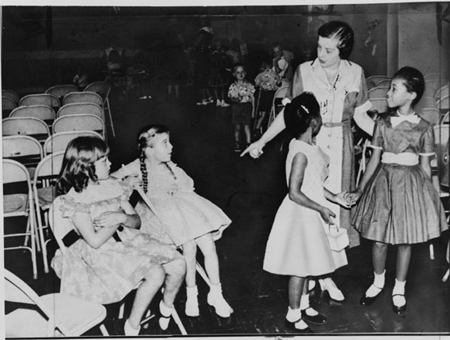Connecting to the Common Core: Analyzing Primary Source Images

Although image analysis activities do not generally require reading (apart from reading bits of text found in an image), the skills required to extract information from visual content are similar to those required to extract information from text. Practicing these skills using primary source images provides students with a great scaffolded learning opportunity. The table below shows how the Common Core State Standards (CCSS) Reading Anchor Standards map to primary source image analysis skills.
| COMMON CORE READING ANCHOR STANDARDS |
IMAGE ANALYSIS SKILLS | |
| √ | 1. Read closely to determine what the text says explicitly and to make logical inferences from it; cite specific textual evidence when writing or speaking to support conclusions drawn from the text. | Analyze an image closely to determine what it conveys explicitly and to make logical inferences from it; cite specific visual evidence when writing or speaking to support conclusions drawn from the image. |
| √ | 2. Determine central ideas or themes of a text and analyze their development; summarize the key supporting details and ideas. | Determine central ideas or themes presented in an image; summarize the key supporting details and ideas. |
| √ | 3. Analyze how and why individuals, events, and ideas develop and interact over the course of a text. | Analyze how and why individuals, events, and ideas develop and interact in a series of thematically related images. |
| √ | 4. Interpret words and phrases as they are used in a text, including determining technical, connotative, and figurative meanings, and analyze how specific word choices shape meaning or tone. | Interpret selected details, symbols and visual techniques as they are used in an image, including determining technical, connotative, and figurative meanings, and analyze how specific choices about what to include in the frame or leave out of the frame shape meaning or tone. |
| √ | 5. Analyze the structure of texts, including how specific sentences, paragraphs, and larger portions of the text (e.g., a section, chapter, scene, or stanza) relate to each other and the whole. | Analyze the composition of an image, analyzing and summarizing the significance of key details to one another and to the image as a whole. |
| √ | 6. Assess how point of view or purpose shapes the content and style of a text. | Assess how point of view or purpose shapes the content and style of an image. |
| √ | 7. Integrate and evaluate content presented in diverse media and formats, including visually and quantitatively, as well as in words. | Integrate and evaluate content presented in diverse media and formats, including visually and quantitatively, as well as in words.[1] |
| √ | 8. Delineate and evaluate the argument and specific claims in a text, including the validity of the reasoning as well as the relevance and sufficiency of the evidence. | Delineate and evaluate the point of view and bias presented in an image, including the validity of the reasoning as well as the relevance and sufficiency of the evidence. |
| √ | 9. Analyze how two or more texts address similar themes or topics in order to build knowledge or to compare the approaches the authors take. | Analyze how two or more images address similar themes or topics in order to build knowledge or to compare the approaches the creators take. |
| √ | 10. Read and comprehend complex literary and informational texts independently and proficiently. | Analyze and derive meaning from complex documentary and illustrative images independently and proficiently. |
[1] This description exactly matches the Common Core Anchor Reading Standard. Anchor reading standards are the same for K-12.
Please feel free to download and distribute the Image Analysis Common Core State Standards Alignment document (but please keep the format, including logos, intact).
Related PSN Posts
Analyzing Primary Sources: Learning from Images
Connecting to the Common Core: Close Reading Markup Strategies
Connecting to the Common Core: Image Questions & Responses
Connecting to the Common Core: Image Sequencing Activities
Connecting to the Common Core: Primary Source Investigations
Connecting to the Common Core: Primary Source Thinking Triangle Activity
Connecting to the Common Core: Purposeful Questions & Close Observation
